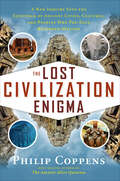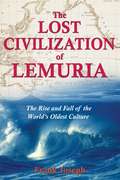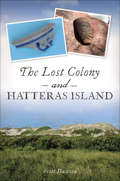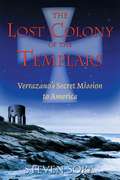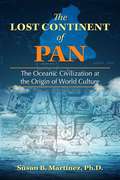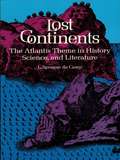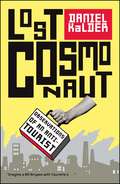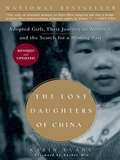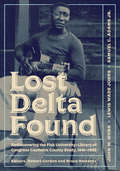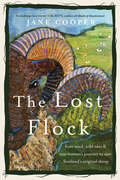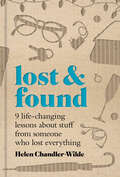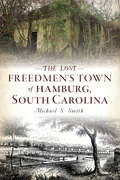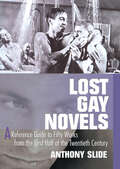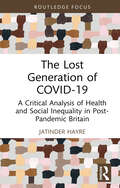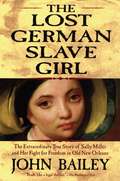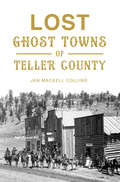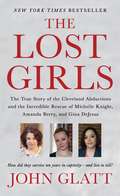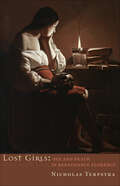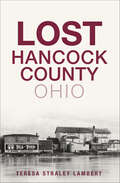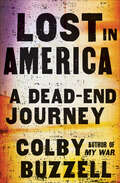- Table View
- List View
The Lost Civilization Enigma: A New Inquiry Into the Existence of Ancient Cities, Cultures, and Peoples Who Pre-Date Recorded History
by Philip CoppensAn examination of archaeological controversies, with arguments showing evidence of prehistoric civilizations not recorded as part of human history.Are history books giving us the whole story? Or is civilization far more complex and older than we have been taught?Our school textbooks barely mention the 6,000-year-old Sumerian civilization, yet the latest archaeological findings at sites such as Jericho and, most recently, Gobekli Tepe in Turkey have been dated to 10,000 BC.Civilization goes back at least another 10,000 years, if we are willing to believe what our ancestors themselves claimed.The Lost Civilization Enigma reveals the truth about:Lost magnitudes to known cultures, such as the Bosnian Pyramids and the civilization of “Old Europe.”The fabled lost “golden” cities of South America and the Amazon, which are slowly being rediscovered.Fascinating examples of lost technology, such as the Antikythera Device.Atlantis and the fact that it was a real civilization.Analyzing the historical and archaeological record, best-selling author Philip Coppens demonstrates that there is substantial evidence that civilization is far older, far more advanced, and far more special than is currently accepted. Clearly, our history books have left out a great deal!
The Lost Civilization of Lemuria: The Rise and Fall of the World’s Oldest Culture
by Frank JosephA compelling new portrait of the lost realm of Lemuria, the original motherland of humanity• Contains the most extensive and up-to-date archaeological research on Lemuria• Reveals a lost, ancient technology in some respects more advanced than modern science• Provides evidence that the perennial philosophies have their origin in Lemurian cultureBefore the Indonesian tsunami or Hurricane Katrina’s destruction of New Orleans, there was the destruction of Lemuria. Oral tradition in Polynesia recounts the story of a splendid kingdom that was carried to the bottom of the sea by a mighty “warrior wave”--a tsunami. This lost realm has been cited in numerous other indigenous traditions, spanning the globe from Australia to Asia to the coasts of both South and North America. It was known as Lemuria or Mu, a vast realm of islands and archipelagoes that once sprawled across the Pacific Ocean. Relying on 10 years of research and extensive travel, Frank Joseph offers a compelling picture of this motherland of humanity, which he suggests was the original Garden of Eden.Using recent deep-sea archaeological finds, enigmatic glyphs and symbols, and ancient records shared by cultures divided by great distances that document the story of this sunken world, Joseph painstakingly re-creates a picture of this civilization in which people lived in rare harmony and possessed a sophisticated technology that allowed them to harness the weather, defy gravity, and conduct genetic investigations far beyond what is possible today. When disaster struck Lemuria, the survivors made their way to other parts of the world, incorporating their scientific and mystical skills into the existing cultures of Asia, Polynesia, and the Americas. Totem poles of the Pacific Northwest, architecture in China, the colossal stone statues on Easter Island, and even the perennial philosophies all reveal their kinship to this now-vanished civilization.
The Lost Colony and Hatteras Island
by Scott DawsonNew archeological discoveries may finally solve the greatest mystery of Colonial America in this history of Roanoke and Hatteras Islands. Established on what is now North Carolina&’s Roanoke Island, the Roanoke Colony was intended to be England&’s first permanent settlement in North America. But in 1590, the entire population disappeared without a trace. The only clue to their fate was the word &“Croatoan&” carved into a tree. For centuries, the legend of the Lost Colony has captivated imaginations. Now, archaeologists from the University of Bristol, working with the Croatoan Archaeological Society, have uncovered tantalizing clues to the fate of the colony. In The Lost Colony and Hatteras Island, Hatteras native and amateur archaeologist Scott Dawson compiles what scholars know about the Lost Colony along with what scholars have found beneath the soil of Hatteras.
The Lost Colony of the Templars: Verrazano's Secret Mission to America
by Steven SoraReveals the existence of a Templar colony in the New World and how the explorer Verrazano, also a member of a secret society, attempted to reestablish contact with it • Explores Columbus’s connection to Henry Sinclair’s maps of the New World • Examines the secret alliance of Catholic Sulpicians and French Huguenots to preserve the Templar legacy • Reveals the hidden knowledge preserved in the Templar baptisteries found throughout Europe and in Newport, Rhode Island In 1524 the Italian explorer Giovanni da Verrazano was sent by the French king Francis I on an expedition ostensibly to find a shorter route to China. However, his true mission, Steven Sora suggests, was to contact a Templar colony that might have been established in Newport, Rhode Island, by Henry Sinclair at the end of the 14th century. In his expedition log Verrazano recorded that his only stay on this journey was at Newport Harbor, the site of a tower built to the exact measurements of a Templar baptistery, a sacred sanctuary representing baptism and eternal life. This tower is a remnant of Sinclair’s voyage to America nearly a century before that of Columbus (who had access to Sinclair’s maps thanks to his wife, who was Sinclair’s great-granddaughter). While Verrazano’s mission succeeded in finding the tower, the colony itself eluded him. His backers then decided to resurrect the dream of Acadia--a place where they could aspire to higher knowledge without fear of Church or state--by creating a new Secret Society that included Huguenots and Catholic Sulpicians. This Company of the Holy Sacrament would lay the foundations for Montreal in an attempt to realize the ambitions of Sinclair and his Templar companions, as well as to stave off efforts by the Jesuits to transform Quebec into a fiefdom of the orthodox Church. Quebec’s motto, “Je me souviens” (I remember), is a reference to this secret history.
The Lost Continent of Pan: The Oceanic Civilization at the Origin of World Culture
by Susan B. MartinezReveals the Pacific Ur-culture that seeded the ancient civilizations of China, Egypt, India, Mexico, and Peru• Shows how the Pan diaspora explains the similarities between Gobekli Tepe and Toltec carvings and stone towers in Japan and on Easter Island• Reveals the mother tongue of Pan hidden in shared word roots in vastly different languages, including Quechua, Sanskrit, Japanese, Greek, and Sumerian• Explains the red-haired Caucasian mummies of China, the Ainu of Japan, the presence of “white” humans in early Native American legend, and other light-skinned peoples found in Southeast Asia and the Middle EastThe destruction of the vast continent of Pan--also known as Lemuria or Mu--in the Pacific Ocean 24,000 years ago was the greatest catastrophe that ever befell humanity. Yet it resulted in a prehistoric Golden Age of arts and technology thanks to the Sons of Noah, who, forewarned and prepared for the disaster, escaped in 5 organized fleets. Theirs was the masterful Ur-culture that seeded China, Egypt, India, Mexico, and Peru, explaining the sudden injection of the same advanced knowledge and sophisticated arts into those widely separated lands. Examining the diaspora from the sunken continent of Pan, Susan B. Martinez finds traces of the oceanic Pan civilization in arts and technologies from canal-works, masonry, and agriculture to writing, weaving, and pottery, but most importantly in the art of navigation, the hallmark of the survivors of the catastrophe. Using archaeo-linguistic analysis, she reveals the mother tongue of Pan hidden in strikingly similar words for royalty, deities, and important places in vastly different languages, including Quechua, Maori, Sanskrit, Japanese, Chinese, Greek, and Sumerian, as well as English through the prefix “pan” which denotes “all-encompassing.” The author reveals how the Pan diaspora explains the mound builders on each continent, the presence of “white” humans in Native American legend, the red-haired mummies found in China, and the Ainu of Japan. She shares recent genetic studies that reveal Polynesian DNA in central Europeans, Mesopotamians, South Americans, and the 9000-year-old Kennewick man and shows how Pan provides the missing link. She reveals why carvings at Gobekli Tepe are similar to Toltec artistry, why stone towers in Japan and Easter Island are identical, and how the Pacific Ring of Fire was activated. Moving the Garden of Eden from the Fertile Crescent to the South Seas, Martinez strikes down the pervasive view of Atlantis as the source of ancient knowledge and exposes the original unity of mankind on the ancient Pacific continent of Pan.
Lost Continents
by L. Sprague CampA leading authority examines the facts and fancies behind the Atlantis theme in history, science, and literature. Sources include the classical works from which Plato drew his proposal of the existence of an island continent, Sir Thomas More's Utopia, the Lemurian Continent theory, K. T. Frost's equation of Atlantis with Crete, and many other citations of Atlantis in both famous and lesser-known literature. Related legends are also recounted and refuted, and reports include accounts of actual expeditions searching for the sunken continent and attempts to prove its existence through comparative anatomy and zoology.
Lost Cosmonaut: Observations of an Anti-Tourist
by Daniel KalderDaniel Kalder belongs to a unique group: the anti-tourists. Sworn to uphold the mysterious tenets ofThe Shymkent Declarations, the anti-tourist seeks out the dark, lost zones of our planet, eschewing comfort, embracing hunger and hallucinations, and always traveling at the wrong time of year. In Lost Cosmonaut, Kalder visits locations that most of us don't even know exist -- Tatarstan, Kalmykia, Mari El, and Udmurtia. He loves these places because no one else does, because everyone else passes them by. A tale of adventure, conversation, boredom, and observation -- occasionally enhanced by an overactive imagination -- Kalder reveals a world of hidden cities, lost rites, mail-order brides, machine guns, mutants, and cold, cold emptiness. In the desert wastelands of Kalmykia, he stumbles upon New Vasyuki, the only city in the world dedicated to chess. In Mari El, home to Europe's last pagan nation, he meets the chief Druid and participates in an ancient rite; while in the bleak industrial badlands of Udmurtia, Kalder searches for Mikhail Kalashnikov, inventor of the AK-47, and inadvertently becomes a TV star. An unorthodox mix of extraordinary stories woven together with fascinating history, peculiar places, and even stranger people,Lost Cosmonautis poetic and profane, hilarious and yet oddly heartwarming, bizarre and even educational. In short, it's the perfect guide to the most alien planet in our cosmos: Earth.
The Lost Daughters of China
by Karin EvansIn 1997 journalist Karin Evans walked into an orphanage in southern China and met her new daughter, a beautiful one-year-old baby girl. In this fateful moment Evans became part of a profound, increasingly common human drama that links abandoned Chinese girls with foreigners who have traveled many miles to complete their families. At once a compelling personal narrative and an evocative portrait of contemporary China, The Lost Daughters of China has also served as an invaluable guide for thousands of readers as they navigated the process of adopting from China. However, much has changed in terms of the Chinese government?s policies on adoption since this book was originally published and in this revised and updated edition Evans addresses these developments. Also new to this edition is a riveting chapter in which she describes her return to China in 2000 to adopt her second daughter who was nearly three at the time. Many of the first girls to be adopted from China are now in the teens (China only opened its doors to adoption in the 1990s), and this edition includes accounts of their experiences growing up in the US and, in some cases, of returning to China in search of their roots. Illuminating the real-life stories behind the statistics, The Lost Daughters of China is an unforgettable account of the red thread that winds form China?s orphanages to loving families around the globe. .
Lost Delta Found: Rediscovering the Fisk University-Library of Congress Coahoma County Study, 1941-1942
by John W. Work III Lewis Wade Jones Samuel C. Adams Jr.Blues Hall of Fame Inductee—Named a "Classic of Blues Literature" by the Blues Foundation, 2019 This remarkable book recovers three invaluable perspectives, long thought to have been lost, on the culture and music of the Mississippi Delta. In 1941 and '42 African American scholars from Fisk University—among them the noted composer and musicologist John W. Work, sociologist Lewis Wade Jones, and graduate student Samuel C. Adams Jr.—joined folklorist Alan Lomax of the Library of Congress on research trips to Coahoma County, Mississippi. Their mission was to explore the musical habits and history of the black community there and "to document adequately the cultural and social backgrounds for music in the community." Among the fruits of the project were the earliest recordings by the legendary blues singer and guitarist Muddy Waters. The hallmark of the study was to have been a joint publication of its findings by Fisk and the Library of Congress. However, the field notes and manuscripts by the Fisk researchers became lost in Washington. Lomax's own book drawing on the project's findings, The Land Where the Blues Began, did not appear until 1993, and although it won a National Book Critics Circle Award, it was flawed by a number of historical inaccuracies. Recently uncovered by author and filmmaker Robert Gordon, the writings, interviews, notes, and musical transcriptions produced by Work, Jones, and Adams in the Coahoma County study now appear in print for the first time. Their work captures, with compelling immediacy, a place, a people, a way of life, and a set of rich musical traditions as they existed sixty years ago. Until the surfacing of these documents, Lomax's perspective was all that was known of the Coahoma County project and its research. Now, at last, the voices of the other contributors can be heard. Including essays by Bruce Nemerov and Gordon on the careers and contributions of Work, Jones, and Adams, Lost Delta Found will become an indispensable historical resource, as marvelously readable as it is enlightening. Illustrated with photos and more than 160 musical transcriptions.
Lost Delta Found: Rediscovering the Fisk University-Library of Congress Coahoma County Study, 1941-1942
by John W Work III Lewis Wade Jones Samuel C Adams JrBlues Hall of Fame Inductee—Named a "Classic of Blues Literature" by the Blues Foundation, 2019 This remarkable book recovers three invaluable perspectives, long thought to have been lost, on the culture and music of the Mississippi Delta. In 1941 and &’42 African American schol-ars from Fisk University—among them the noted composer and musicologist John W. Work III, sociologist Lewis Wade Jones, and graduate student Samuel C. Adams Jr.—joined folklorist Alan Lomax of the Library of Congress on research trips to Coahoma County, Mississippi. Their mission was &“to document adequately the cultural and social backgrounds for music in the community.&” Among the fruits of the project were the earliest recordings by the legendary blues singer and guitarist Muddy Waters. The hallmark of the study was to have been a joint publication of its findings by Fisk and the Library of Congress. While this publication was never completed, Lost Delta Found is composed of the writings, interviews, notes, and musical transcriptions produced by Work, Jones, and Adams in the Coahoma County study. Their work captures, with compelling immediacy, a place, a people, a way of life, and a set of rich musical traditions as they existed in the 1940s. Illustrated with photos and more than 160 musical transcriptions.
The Lost Flock: Rare Wool, Wild Isles and One Woman’s Journey to Save Scotland’s Original Sheep
by Jane CooperThe Lost Flock is the story of the remarkable and rare little horned sheep, known as Orkney Boreray, and the wool-obsessed woman who moved to one of Scotland’s wildest islands to save them. It was Jane Cooper’s passion for knitting that led her to discover the world of rare-breed sheep and their wool. Through this, Jane uncovered the ‘Orkney Borerary’ – a unique group within the UK’s rarest breed of sheep, the Boreray, and one of the few surviving examples of primitive sheep in northern Europe. As her knowledge of this rarest of heritage breeds grew, she took the bold step to uproot her quiet suburban life in Newcastle and relocate to Orkney, embarking on a new adventure and life as farmer and shepherd. Jane was astonished to find that she was the sole custodian of this lost flock in the world, and so she began investigating their mysterious and ancient history, tracking down the origins of the Boreray breed and its significance to Scotland’s natural heritage. From Viking times to Highland crofts and nefarious research experiments in Edinburgh, this is a so-far untold real-life detective story. It is also the story of one woman’s relentless determination to ensure a future for her beloved sheep, and in doing so revealing their deep connection to the Scottish landscape. An unforgettable story of a heritage breed and the importance of its existence.
Lost & Found: Nine life-changing lessons about stuff from someone who lost everything
by Helen Chandler-WildeWhy do we buy and keep the things we do, and how can we live a less cluttered life? Journalist Helen Chandler-Wilde dives deep to explore, explain, and guide us on the path to liberation from the tyranny of "too much."On New Year's Eve of 2018, Helen Chandler-Wilde lost everything she owned in a storage unit fire in Croydon, England, where she'd stowed all her possessions after a big breakup. She was left devastated and forced to re-evaluate her relationship with owning material things.In Lost & Found, she offers a profound mix of memoir, self-help, and journalism to explore the psychological reasons, sociological quirks of human nature, and fascinating science behind why we buy and hold onto things. Helen interviews people from all walks of life, including behavioral psychologists on the science of nostalgia, a nun on what it's like to own almost nothing, and consumer psychologists on why we spend impulsively, to help us better understand why we're surrounded by clutter and what we can do to change it.By the end of this smart-thinking book filled with lessons and engaging prompts to help us gain perspective on our buying habits and the value we place on what we already have, your relationship with your belongings will be changed forever. The perfect "new year, new you" read or gift for anyone who is downsizing, striving for a more sustainable lifestyle, or is eager to cultivate a minimalist mindset.
The Lost Freedmen's Town of Hamburg, South Carolina (Lost)
by Michael S. SmithHamburg is perhaps South Carolina's most famous ghost town. Founded in 1821, it grew to four thousand residents before transportation advances led to decline. During Reconstruction, recently freed slaves reshaped Hamburg into a freedmen's village, where residents held local, county and state offices. These gains were wiped away after the Hamburg Massacre in 1876, a watershed event that left seven African Americans dead, most of them executed in cold blood. Yet more than a century after Hamburg, the one white supremacist killed in the melee is canonized by the racially divisive Meriwether Monument in downtown North Augusta. Author Michael Smith details the amazing events that created this unique community with a lasting legacy.
Lost Gay Novels: A Reference Guide to Fifty Works from the First Half of the Twentieth Century
by Anthony SlideSearching for an introduction to the shadowy, intriguing world of early 20th century gay-themed fiction? In Lost Gay Novels, respected pop culture historian Anthony Slide resurrects fifty early 20th century American novels with gay themes or characters and discusses them in carefully researched, engaging prose. Each entry offers you a detailed discussion of plot and characters, a summary of contemporary critical reception, and biographical information on the often-obscure writer. In Lost Gay Novels, another aspect of gay life and society is, in the words the author, "uncloseted," providing you with an absorbing glimpse into the world of these nearly forgotten books. Lost Gay Novels gives you an introduction to: authors who aren't usually associated with homosexuality, including John Buchan, James M. Cain, and Rex Stout the history of gay publishing in the US and abroad gay themes in novels published between 1917 and 1950-with entries from nearly every year! the ways in which the popular culture of the time shaped the authors' attitudes toward homosexuality the difficulty of finding detailed biographical information on little-known authors If you're interested in gay studies or history, or even if you're just looking for a comprehensive guide to titles you've probably never heard of before, Lost Gay Novels will be a welcome addition to your collection. The introduction from author Slide-called by the Los Angeles Times "a one-man publishing phenomenon"-provides you with an overview to the basics of this landmark collection. Themes found in many of the titles include death, secrecy, and living a double life, and in reading the entries you will discover just why these themes are so common. As Slide says in his introduction: "The approach of the novelist toward homosexuality may not always be a positive one... but the works are important to an understanding of contemporary attitudes toward gay men and gay society." Lost Gay Novels will help you further your own understanding of the dynamic relationship between literature and culture, and you will finish the book with a greater appreciation of modern American gay fiction.
The Lost Generation of COVID-19: A Critical Analysis of Health and Social Inequality in Post-Pandemic Britain
by Jatinder HayreThe COVID-19 pandemic has wrought unparalleled disruption, altering the landscape of health and well-being for a generation. The Lost Generation of COVID-19 unveils the ways in which the crisis has deepened existing health disparities, casting a long shadow over young people’s futures.Set against the backdrop of austerity-induced cuts to UK public services, this book explores the social determinants of health, revealing how systemic neglect has been exacerbated by the pandemic’s relentless pressure. The analysis extends beyond individual hardships, illuminating the broader societal ramifications such as economic stagnation and social fragmentation. Yet, amidst the bleak landscape, the book offers a visionary perspective on the potential for transformative change. It posits that the pandemic serves as a catalyst for radical societal reform, advocating for a new economic paradigm anchored in equity and fairness. By addressing the root causes of health inequalities through innovative policy interventions and structural reforms, the author envisions a resilient and just society emerging from the shadows of the pandemic.Insightful and far-reaching, this book is an indispensable resource for students and scholars in the health sciences and political science, as well as for policymakers dedicated to these important issues.
Lost German Chicago (Images of America)
by Joseph C. Heinen Susan Barton HeinenBy 1900, one in four Chicagoans was either German born or had a German-born parent. No other ethnic group's thumbprint has been larger in helping establish Chicago as a major economic and cultural center nor has any group's influence been more erased by the passage and vicissitudes of time. Lost German Chicago traces the mosaic of German life through the tumultuous events of the Beer Riots, Haymarket Affair, Prohibition, and America's entry into two world wars. The book is a companion piece to the Lost German Chicago exhibition debuting in the newly created DANK-Haus German American Cultural Center museum, located in what is still known today as the "German town" of the north side of Chicago. Entrusted as the caretaker of many archives, artifacts, and historical documents from many now defunct German organizations, the DANK-Haus German American Cultural Center has been committed to preserving history, traditions, and contributions of Germans and German Americans for over 50 years.
The Lost German East
by Andrew DemshukA fifth of West Germany's post-1945 population consisted of ethnic German refugees expelled from Eastern Europe, a quarter of whom came from Silesia. As the richest territory lost inside Germany's interwar borders, Silesia was a leading objective for territorial revisionists, many of whom were themselves expellees. The Lost German East examines how and why millions of Silesian expellees came to terms with the loss of their homeland. Applying theories of memory and nostalgia, as well as recent studies on ethnic cleansing, Andrew Demshuk shows how, over time, most expellees came to recognize that the idealized world they mourned no longer existed. Revising the traditional view that most of those expelled sought a restoration of prewar borders so they could return to the east, Demshuk offers a new answer to the question of why, after decades of violent upheaval, peace and stability took root in West Germany during the tense early years of the Cold War.
The Lost German Slave Girl: The Extraordinary True Story Of The Slave Sally Miller And Her Fight For Freedom In Old New Orleans
by John BaileyIt is a spring morning in New Orleans, 1843. In the Spanish Quarter, on a street lined with flophouses and gambling dens, Madame Carl recognizes a face from her past. It is the face of a German girl, Sally Miller, who disappeared twenty-five years earlier. But the young woman is property, the slave of a nearby cabaret owner. She has no memory of a "white" past. Yet her resemblance to her mother is striking, and she bears two telltale birthmarks. In brilliant novelistic detail, award-winning historian John Bailey reconstructs the exotic sights, sounds, and smells of mid-nineteenth-century New Orleans, as well as the incredible twists and turns of Sally Miller's celebrated and sensational case. Did Miller, as her relatives sought to prove, arrive from Germany under perilous circumstances as an indentured servant or was she, as her master claimed, part African, and a slave for life? A tour de force of investigative history that reads like a suspense novel, The Lost German Slave Girl is a fascinating exploration of slavery and its laws, a brilliant reconstruction of mid-nineteenth-century New Orleans, and a riveting courtroom drama. It is also an unforgettable portrait of a young woman in pursuit of freedom.
Lost Ghost Towns of Teller County (Lost)
by Jan Mackell CollinsThroughout Teller County, history lovers can find abandoned towns and forgotten main streets that once bustled with life and commerce. Even before Teller was carved from surrounding counties, the scenic mountains and lucrative mines of the gold rush era brought thousands of settlers and attracted resort owners and tycoons eager to exploit the rich setting. Seemingly overnight, towns in the Cripple Creek District and other places popped up, flush with gold and people looking for opportunity. As the ore disappeared, the miners moved on in search of the next big lode. One by one, the towns were all but forgotten. Join Jan MacKell Collins and discover the booming history, lost towns and hardy settlers of Teller County.
The Lost Girls: The True Story Of The Cleveland Abductions And The Incredible Rescue Of Michelle Knight, Amanda Berry, And Gina Dejesus
by John GlattThey were held in brutal captivity—and managed to make it out alive. This is their story.
Lost Girls: Sex and Death in Renaissance Florence
by Nicholas TerpstraIn 1554, a group of idealistic laywomen founded a home for homeless and orphaned adolescent girls in one of the worst neighborhoods in Florence. Of the 526 girls who lived in the home during its fourteen-year tenure, only 202 left there alive. Struck by the unusually high mortality rate, Nicholas Terpstra sets out to determine what killed the lost girls of the House of Compassion shelter (Casa della Pietà). Reaching deep into the archives' letters, ledgers, and records from both inside and outside the home, he slowly pieces together the tragic story. The Casa welcomed girls in bad health and with little future, hoping to save them from an almost certain life of poverty and drudgery. Yet this "safe" house was cruelly dangerous. Victims of Renaissance Florence’s sexual politics, these young women were at the disposal of the city’s elite men, who treated them as property meant for their personal pleasure. With scholarly precision and journalistic style, Terpstra uncovers and chronicles a series of disturbing leads that point to possible reasons so many girls died: hints of routine abortions, basic medical care for sexually transmitted diseases, and appalling conditions in the textile factories where the girls worked. Church authorities eventually took the Casa della Pietà away from the women who had founded it and moved it to a better part of Florence. Its sordid past was hidden, until now, in an official history that bore little resemblance to the orphanage’s true origins. Terpstra’s meticulous investigation not only uncovers the sad fate of the lost girls of the Casa della Pietà but also explores broader themes, including gender relations, public health, church politics, and the challenges girls and adolescent women faced in Renaissance Florence.
Lost Hancock County, Ohio (Lost)
by Teresa Straley LambertFrom a swampy forest, Hancock County grew to a hub of agriculture, industry and culture. The promise of free fuel and land brought numerous factories to Findlay. One, the Dalzell, Gilmore & Leighton Glass Company, left a lasting legacy of collectible glassware. The need to drain fields and presence of a ready supply of clay encouraged the growth of brick and tile factories in Rawson, Arlington, McComb and Findlay. Entertainment and culture arrived in many forms. Sam Reeves Park in Arcadia featured vaudeville shows, baseball games and amusement rides. At Findlay's Riverside Park, the Green Mills Dance Hall hosted everyone from the Glenn Miller and Count Basie bands to Naked Onion and Mixed Emotions. Join Teresa Straley Lambert as she presents the vanished heritage of mills, milking, masks, medicine and more.
Lost History: The Enduring Legacy of Muslim Scientists, Thinkers, and Artists
by Michael Hamilton MorganIn an era when the relationship between Islam and the West seems mainly defined by mistrust and misunderstanding, it is important to remember that for centuries Muslim civilization was the envy of the world. Lost History fills a significant void and is essential reading for anyone seeking to understand the major the early Muslims played in influencing modern society. Morgan reveals how early Muslim advancements in science and culture laid the cornerstones of the European Renaissance, the Enlightenment, and modern Western society. As he chronicles the Golden Ages of Islam, beginning in A.D. 570 with the birth of Muhammad, and resonating today, he introduces scholars like Ibn Al-Haytham, Ibn Sina, Al-Tusi, Al-Khwarizmi, and Omar Khayyam, towering figures who revolutionized the mathematics, astronomy, and medicine of their time and paved the way for Newton, Copernicus, and many others. And he reminds us that inspired leaders from Muhammad to Suleiman the Magnificent and beyond championed religious tolerance, encouraged intellectual inquiry, and sponsored artistic, architectural, and literary works that still dazzle us with their brilliance. Lost History finally affords pioneering leaders with the proper credit and respect they so richly deserve.
The Lost Horse: A Chinese Folktale
by Ed Young Tracey AdamsThe Caldecott Medalist's magnificent illustrations combine paint and paper collage to animate this ancient Chinese story of a wild horse that brings extraordinary reversals of fortune to its trusting owner. Three removable, cut-paper puppets invite young readers to act out the story and to create exciting new tales of their own.
Lost in America: A Dead-End Journey
by Colby Buzzell"Nothingless than the soul of an extremely interesting human being at war on ourbehalf." —Kurt VonnegutAstunning portrait of modern America by Colby Buzzell,the critically acclaimed author of My War: Killing Time in Iraq.Recounting his five-month journey through the country, from its thrivingcoastlines to its rust-belt wrecks, Buzzell reveals aparadoxical landscape of American dreams both achieved and broken, manifestdestinies claimed and refuted, and community ties pulled apart and patchedtogether. In the tradition of John Steinbeck’s Travels with Charley, Buzzell’s Lost in America uncovers the starkrealities of our national character even as it explores the deepest questionsof identity, unity, and fatherhood.
